
The Piedmont Exposition of 1887 was the first exposition ever held in Piedmont Park in Atlanta, Georgia.

The Piedmont Exposition of 1887 was the first exposition ever held in Piedmont Park in Atlanta, Georgia.
The Piedmont Exposition Company was founded in June 1887 by a group of men who met in the offices of the Atlanta Constitution. The company's chief purpose was to organize the Piedmont Exhibition for the purpose of exhibiting the natural resources of the Piedmont region, including Georgia, North Carolina, South Carolina, Tennessee, and Alabama. [1]
| Officers of the Piedmont Exhibition Company | |
|---|---|
| Name | Office |
| Charles A. Collier | President |
| Henry W. Grady | Vice-President |
| Robert J. Lowry | Treasurer |
| Major W.H. Smyth | Secretary |
Planning of the exposition took only 104 days from the time the company was formed. [2] The main plan called for the clearing out of a 189-acre (0.76 km2) forest, an area now known as Piedmont Park, as well as the construction of several expensive buildings and a horse racetrack., [3] [4]
The main building constructed for the Exposition was 570 feet (170 m) long, 126 feet (38 m) wide, and two stories high. [5]
The Piedmont Exposition of 1887, the first exposition ever held in Piedmont Park, opened on October 10. [6] The first day opened with 20,000 visitors. [7] Opening orations were performed by Governor Gordon and Hon. Samuel J. Randall of Pennsylvania. [2] Randall opened the Exposition with a speech on the success of the resurrected post-civil war south. [8] When his speech concluded, General Pierce M. B. Young and his men fired cannons to signal the opening of the events. [8]

Exhibitors showed off a variety of items including works of art, local raw materials like manganese marble, and wood work. [8] Many prominent figures of the day were in attendance to see the displays. Governor David B. Hill of New York spoke at the event as well as President Grover Cleveland who attended with his young wife, Frances Folsom, on October 19. [2] [9] [10] Over 50,000 people were in attendance for Cleveland's speech. [7] The event closed on October 22 with a total attendance of about 200,000. [2] When the exposition was over, civic leaders said that it had successfully expanded Atlanta's reputation as a place to visit and to conduct business. [7]
The Exposition was also a chance for Atlanta to prove that it was ready to host the World's Fair. The executive committee of the fair was invited to attend the event under the bidding of Charles Reynolds, secretary of the Piedmont Exposition Company. [11]
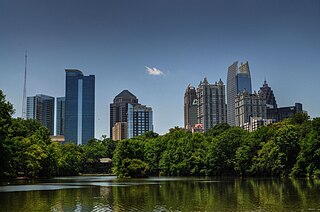
Piedmont Park is an urban park in Atlanta, Georgia, located about 1 mile (1.6 km) northeast of Downtown, between the Midtown and Virginia Highland neighborhoods. Originally the land was owned by Dr. Benjamin Walker, who used it as his out-of-town gentleman's farm and residence. He sold the land in 1887 to the Gentlemen's Driving Club, who wanted to establish an exclusive club and racing ground for horse enthusiasts. The Driving Club entered an agreement with the Piedmont Exposition Company, headed by prominent Atlantan Charles A. Collier, to use the land for fairs and expositions and later gave the park its name.

William Arnold Hemphill was an American businessman and politician who served as Mayor of Atlanta from 1891 to 1893.
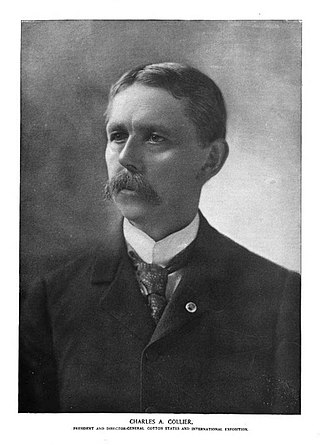
Charles Augustus Collier was an American banker, lawyer, and politician who served as Mayor of Atlanta, Georgia, from 1897 to 1899.

Evan Park Howell was an American politician and early telegraph operator, as well as an officer in the Confederate Army during the American Civil War.
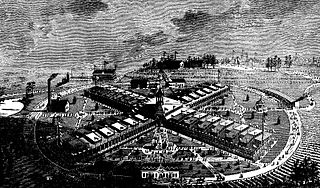
International Cotton Exposition (I.C.E.) was a world's fair held in Atlanta, Georgia, from October 4 to December 31 of 1881. The location was along the Western & Atlantic Railroad tracks near the present-day King Plow Arts Center development in the West Midtown area. It planned to show the progress made since the city's destruction during the Battle of Atlanta and new developments in cotton production. It demonstrated the rebirth of Atlanta and the South by announcing an end to the Reconstruction Era and the sectional hostilities that had plagued the nation for several decades.

Hannibal Ingalls Kimball was an American entrepreneur and important businessman in post-Civil War Atlanta, Georgia.
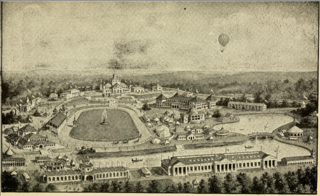
The Cotton States and International Exposition was a world's fair held in Atlanta, Georgia, United States in 1895. The exposition was designed "to foster trade between southern states and South American nations as well as to show the products and facilities of the region to the rest of the nation and Europe."

The Atlanta Exposition Speech was an address on the topic of race relations given by African-American scholar Booker T. Washington on September 18, 1895. The speech, presented before a predominantly white audience at the Cotton States and International Exposition in Atlanta, Georgia, has been recognized as one of the most important and influential speeches in American history. The speech was preceded by the reading of a dedicatory ode written by Frank Lebby Stanton.

George Washington Adair was a real-estate developer in post Civil War Atlanta.

Rufus Brown Bullock was a Republican Party politician and businessman in Georgia. During the Reconstruction Era he served as the state's governor and called for equal economic opportunity and political rights for blacks and whites in Georgia. He also promoted public education for both, and encouraged railroads, banks, and industrial development. During his governorship he requested federal military help to ensure the rights of freedmen; this made him "the most hated man in the state", and he had to flee the state without completing his term. After returning to Georgia and being found "not guilty" of corruption charges, for three decades afterwards he was an esteemed private citizen.
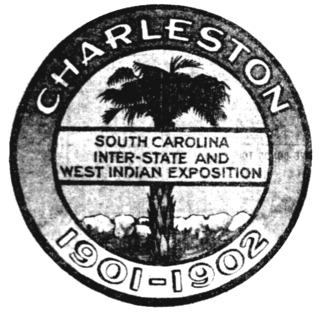
The South Carolina Inter-State and West Indian Exposition, commonly called the Charleston Exposition or the West Indian Exposition, was a multi-county fair and regional trade exposition held in Charleston, South Carolina from December 1, 1901 to June 20, 1902.

Edward Conyngham Peters was an Atlanta real estate developer. He was the son of Richard Peters, a founder of the city.

President of the United States Grover Cleveland's first term (1885-1889) was most notable "for its record number of vetoes (414), more than double the number issued by all his predecessors combined." During Cleveland's first term, controlling Congressional and "wasteful spending" was an important priority for him and his administration. Cleveland's vetoes angered the Grand Army of the Republic (GAR), a powerful organization advocating for Union veterans. In his State of the Union Address in December 1887, President Cleveland called for lower tariffs and tariff reform, making it a major issue in the upcoming 1888 U.S. Presidential election.

Charles Henry James Taylor (1857–1899), was an American journalist, editor, lawyer, orator, and political organizer. An early supporter of Democratic Grover Cleveland, he was appointed Minister to Liberia in Cleveland's first presidential term.
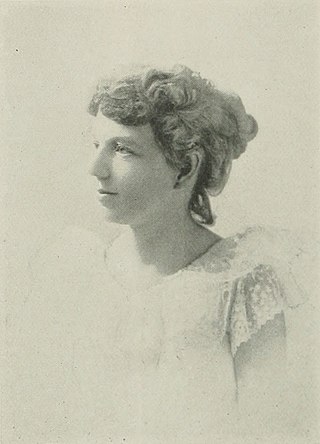
Lollie Belle Wylie was an American poet and composer from Atlanta, Georgia. She was the first paid woman journalist in Georgia and composed the music for the song, which was the official state anthem from 1922 to 1979. She was one of the founders of the Georgia Women's Press Club and the Atlanta Writers Club. In addition to supporting forest preservation, Wylie was the historian for the "Uncle Remus" Memorial Association. In 2013, she was inducted into the Georgia Women of Achievement.

Irvine Garland Penn was an American educator, journalist, and lay leader in the Methodist Episcopal Church. He was the author of The Afro-American Press and Its Editors, published in 1891, and a coauthor with Frederick Douglass, Ida B. Wells, and Ferdinand Lee Barnett of The Reason Why the Colored American Is Not in the World's Columbia Exposition in 1893. In the late 1890s, he became an officer in the Methodist Episcopal Church and played an important role advocating for the interests of African Americans in the church until his death.

Brigadier-General John Randolph Lewis was an American dentist, soldier, administrator, and postmaster, known for his work with the Freedmen's Bureau.
Oglethorpe Park was a municipal park in Atlanta, Georgia, United States. The park, consisting of about 50 acres (20 ha), was created in 1869 and hosted numerous fairs, most notably the International Cotton Exposition in 1881. Following this exposition, the park was sold by the city and was converted into the Exposition Cotton Mills, utilizing facilities that had been built for the event. The closure of the park indirectly contributed to the creation of two later parks in Atlanta: Grant Park and Piedmont Park.